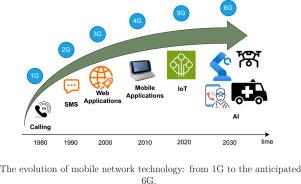Exploring healthcare in the 6G and AI era: Opportunities and challenges
IF 7.6
3区 计算机科学
Q1 COMPUTER SCIENCE, INFORMATION SYSTEMS
引用次数: 0
Abstract
The integration of AI with emerging 6G wireless communications promises to revolutionize healthcare delivery by providing ultra-fast, reliable, and intelligent medical services. Unlike previous generations of mobile phones, 6G is expected to offer sub-millisecond latency, data rates up to terabits per second, and connectivity for more than 10 million devices per square kilometer. Together, these technologies will enable unprecedented healthcare applications, such as real-time remote robotic surgery, holographic telemedicine, and continuous monitoring using bio-nanosensors within the bio-nano-internet of things.
This survey systematically analyzes the integration of AI and 6G technologies, focusing on how their convergence will enable enhanced edge computing, federated and generative AI models, low-latency analytics for personalized treatment, predictive diagnostics, and efficient resource utilization. We present a comprehensive comparison of 5G and 6G architectures, highlighting the limitations of current systems and demonstrating how 6G advancements can address critical healthcare needs, including data throughput, mobility, and security.
Furthermore, this work identifies detailed opportunities, such as AI-powered virtual nurse assistants, AI-enhanced drug discovery accelerated by hyper-responsive 6G infrastructures, and digital twin-enabled patient simulation. Alongside these opportunities, we critically examine the technical challenges related to spectrum management in the terahertz band, the design of energy-efficient IoT devices, robust data privacy frameworks that integrate federated learning and blockchain technology, ethical considerations surrounding AI explainability, and equitable access to healthcare.
By filling gaps in the existing literature, this paper presents a comprehensive framework that combines AI and 6G, specifically designed for healthcare systems. Our findings underscore the transformative potential of this combination for achieving proactive and accessible healthcare, while outlining a roadmap for overcoming prevailing technical, ethical, and infrastructural barriers.

探索6G和人工智能时代的医疗保健:机遇与挑战
人工智能与新兴的6G无线通信的集成有望通过提供超快速、可靠和智能的医疗服务来彻底改变医疗保健服务。与前几代移动电话不同,6G预计将提供亚毫秒级的延迟,高达每秒太比特的数据速率,以及每平方公里超过1000万台设备的连接。总之,这些技术将实现前所未有的医疗保健应用,如实时远程机器人手术、全息远程医疗,以及在生物纳米物联网中使用生物纳米传感器进行连续监测。本调查系统地分析了人工智能和6G技术的集成,重点关注它们的融合将如何实现增强的边缘计算、联合和生成人工智能模型、个性化治疗的低延迟分析、预测诊断和高效的资源利用。我们对5G和6G架构进行了全面比较,强调了当前系统的局限性,并展示了6G的进步如何解决关键的医疗保健需求,包括数据吞吐量、移动性和安全性。此外,这项工作还确定了详细的机会,例如人工智能驱动的虚拟护士助理,超响应6G基础设施加速的人工智能增强药物发现,以及数字双胞胎患者模拟。除了这些机会,我们还仔细研究了与太赫兹频段频谱管理相关的技术挑战、节能物联网设备的设计、集成联邦学习和区块链技术的强大数据隐私框架、围绕人工智能可解释性的道德考虑以及公平获得医疗保健。通过填补现有文献的空白,本文提出了一个综合框架,结合了人工智能和6G,专门为医疗保健系统设计。我们的研究结果强调了这种结合在实现主动和可获得的医疗保健方面的变革潜力,同时概述了克服普遍的技术、道德和基础设施障碍的路线图。
本文章由计算机程序翻译,如有差异,请以英文原文为准。
求助全文
约1分钟内获得全文
求助全文
来源期刊

Internet of Things
Multiple-
CiteScore
3.60
自引率
5.10%
发文量
115
审稿时长
37 days
期刊介绍:
Internet of Things; Engineering Cyber Physical Human Systems is a comprehensive journal encouraging cross collaboration between researchers, engineers and practitioners in the field of IoT & Cyber Physical Human Systems. The journal offers a unique platform to exchange scientific information on the entire breadth of technology, science, and societal applications of the IoT.
The journal will place a high priority on timely publication, and provide a home for high quality.
Furthermore, IOT is interested in publishing topical Special Issues on any aspect of IOT.
 求助内容:
求助内容: 应助结果提醒方式:
应助结果提醒方式:


